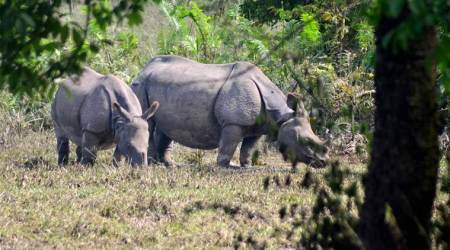 Jamuna with her second calf in Manas National Park. (Source: Gobinda Garh/Assam Forest Department)
Jamuna with her second calf in Manas National Park. (Source: Gobinda Garh/Assam Forest Department)
Jamuna, a female rhino that was rehabilitated in the Manas National Park bordering Bhutan in western Assam, on Sunday gave birth a calf – her second since she was shifted there – with conservationists hailing it as another significant milestone in the collective efforts to restore the lost glory of the Park.
While a group of frontline forest staff of the Bansbari Range of the 950 sq km National Park first saw the new-born calf during their early morning patrol, it was later officially confirmed by a three-member field team of the Greater Manas Conservation Project. The project is jointly run by the Assam forest department with Wildlife Trust of India (WTI), the International Fund for Animal Welfare (IFAW) and the BTC forest department.
“This is the sixth calf born to the rhinos rehabilitated under our project and marks another significant milestone in our collective efforts to restore Manas to its former glory,” Bhaskar Choudhury, Wildlife Trust of India’s head veterinarian in the Manas project, said. “It is a matter of great pride for IFAW-WTI, and the forest department. We must also thank the local community for their continuing tolerance towards rhinos despite instances of crop raiding,” he said.
Jamuna, the female rhino, originally belonged to Kaziranga National Park, and was rescued by forest staff during the 2004 floods in Kaziranga National Park to be subsequently hand-raised in the Centre for Wildlife Rehabilitation and Conservation (CWRC). She was translocated to Manas and released into the wild in November 2010, following which she gave birth to her first calf, a female, in 2014. “I’m extremely pleased to receive this news”, said HK Sarma, IFS, Field Director, Manas National Park. “This is the first rhino calf born in Manas in nearly 20 months. We are expecting the arrival of a couple of more calves in the next few months. Manas has witnessed the birth of 15 rhino calves since translocation began in 2008,” he said
Several years of armed insurgency had led to massive destruction of the Manas National Park between 1988 and 2001, which had also wiped out its 100-plus rhino population. The Assam forest department however began translocating rhinos there under the Indian Rhino Vision 2020 programme since 2008. But, while altogether 27 rhinos were translocated to Manas since 2008, ten were killed by poachers, while three had died of natural reasons.

